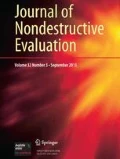Abstract
Ultrasonic reflection measurements from material interfaces are commonly used to detect and quantitatively characterize boundary imperfections of different kinds. Either shear or longitudinal waves can be used to assess the degree of the interface imperfection in acoustical terms. On the other hand, the evaluation of this data in terms of strength-related mechanical properties requiresa priori knowledge of the physical nature of the imperfection. It is shown in this paper that the ratio between the normal and transverse interfacial stiffnesses can be used to classify the interface imperfection. This ratio is readily measured, e.g., by comparing the longitudinal and shear reflection coefficients at normal incidence. Both theoretical and experimental results indicate that different types of imperfections, such as kissing, partial, and slip bonds, can be distinguished by this simple technique.
Similar content being viewed by others
References
J. P. Jones and J. S. Whittier,J. Appl. Mech 34905 (1967).
H. G. Tattersall,J. Phys. 6819 (1973).
M. Schoenberg,J. Acoust. Soc. Am. 681516 (1980).
J. M. Baik and R. B. Thompson,J. Nondestr. Eval. 4177 (1984).
R. B. Thompson and C. J. Fiedler, inReview of Progress in Quantitative Nondestructive Evaluation (Plenum, New York, 1984), Vol. 3A, pp. 207–215.
Y. C. Angel and J. D. Achenbach,J. Appl. Mech. 5233 (1985).
Y. C. Angel and J. D. Achenbach, inReview of Progress in Quantitative Nondestructive Evaluation (Plenum, New York, 1985), Vol. 4A, pp. 83–89.
A. Pilarski and J. L. Rose,J. Appl. Phys. 63300 (1988).
F. J. Margetan, R. B. Thompson, and T. A. Gray,J. Nondestr. Eval. 7131 (1988).
L. J. Pyrak-Nolte, L. R. Myer, and N. G. W. Look,J. Geophys. Res. 958617 (1990).
D. A. Sotiropoulos and J. D. Achenbach,J. Nondestr. Eval. 7123 (1988).
P. B. Nagy and L. Adler, inElastic Waves and Ultrasonic Nondestructive Evaluation (North Holland, Amsterdam, 1990), pp. 229–239.
P. B. Nagy and L. Adler, inReview of Progress in Quantitative Nondestructive Evaluation (Plenum, New York, 1991), Vol. 10A, pp. 177–184.
S. I. Rokhlin, M. Hefets, and M. J. Rosen,J. Appl. Phys. 522847 (1981).
P. B. Nagy and L. Adler,J. Nondestr. Eval. 7199 (1988).
P. B. Nagy,J. Adhesion Sci. Technol. 5619 (1991).
N. F. Haines, The Theory of Sound Transmission and Reflection at Contacting Surfaces, CEGB Report RD-B-N4744, Berkeley Nuclear Laboratories, 1980.
A. B. Wooldridge, The Effects of Compressive Stress on the Ultrasonic Response of Steel-Steel Interfaces and of Fatigue Cracks, CEGB Report NW-SSD-RR-42-79, Berkeley Nuclear Laboratories, 1979.
N. Yoshioka and C. H. Scholz,J. Geophys. Res. 9417681 (1989).
N. Yoshioka and C. H. Scholz,J. Geophys. Res. 9417691 (1989).
Y. C. Angel and J. D. Achenbach,Wave Motion 7375 (1985).
D. A. Sotiropoulos and J. D. Achenbach,J. Acoust. Soc. Am. 84752 (1988).
H. Tada, P. Paris, and G. Irwin,The Stress Analysis of Cracks Handbook (Del Research, St. Louis, 1973).
J. H. Rose, inReview of Progress in Quantitative Nondestructive Evaluation (Plenum, New York, 1989), Vol. 8B, pp. 1925–1931.
J. E. Gubernatis, E. Domany, and J. A. Krumhansl,J. Appl. Phys. 482804 (1977).
J. E. Eshelby,Proc. Roy. Soc. London 241A376 (1957).
J. E. Gubernatis and E. J. Domany,J. Appl. Phys. 50818 (1979).
M. Oshumi, S. Kinyuotou, and M. Sakamato,Trans. Iron Steel Inst. Japan 25513 (1985).
S. I. Rokhlin and Y. J. Wang, inReview of Progress in Quantitative Nondestructive Evaluation (Plenum, New York, 1991), Vol. 10A, pp. 185–192.
S. I. Rokhlin and Y. J. Wang,J. Acoust. Soc. Am. 89503 (1991).
J. D. Eshelby, inProgress in Solid Mechanics (North-Holland, Amsterdam, 1961), Vol. 2, pp. 87–140.
I. Yalda-Mooshabas, F. J. Margetan, T. A. Gray, and R. B. Thompson, inReview of Progress in Quantitative Nondestructive Evaluation (Plenum, New York, 1992), Vol. 11B, pp. 1363–1369.
J. E. Gubernatis, E. Domany, and J. A. Krumhansl,J. Appl. Phys. 482812 (1972).
L. J. Pyrak-Nolte, L. R. Myer, and N. G. W. Cook,J. Geophys. Res. 95 11345 (1990).
C. J. Hsu and M. Schoenberg,J. Acoust. Soc. Am. 88:S46 (1990).
Author information
Authors and Affiliations
Rights and permissions
About this article
Cite this article
Nagy, P.B. Ultrasonic classification of imperfect interfaces. J Nondestruct Eval 11, 127–139 (1992). https://doi.org/10.1007/BF00566404
Received:
Revised:
Issue Date:
DOI: https://doi.org/10.1007/BF00566404



